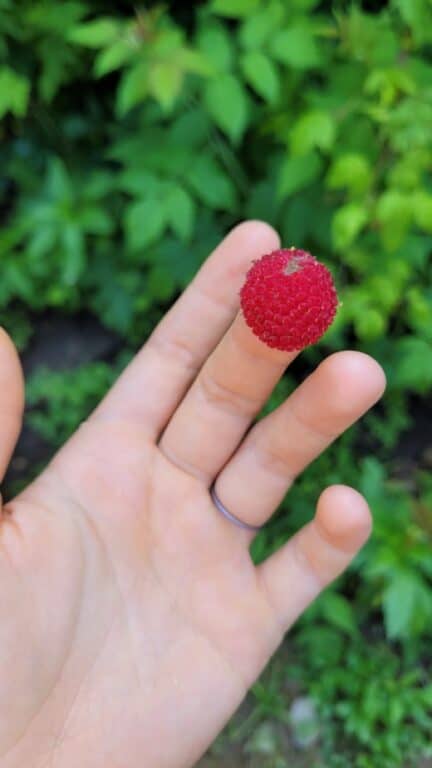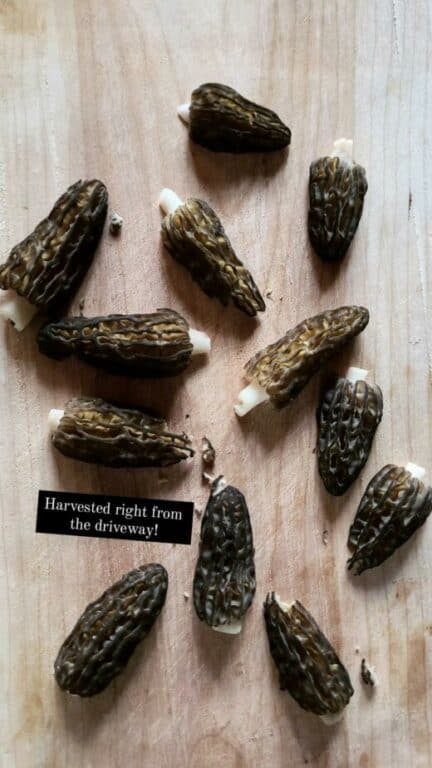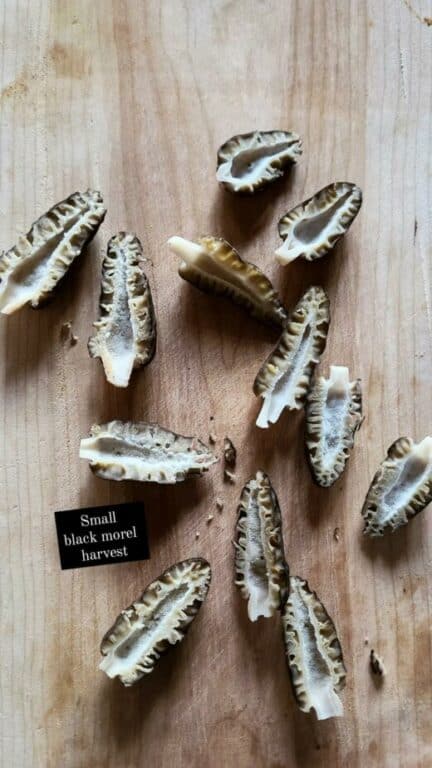This post may contain affiliate links. If you use these links to buy something we may earn a commission. Thanks.
This list is focused on edible perennials (perennial vegetables) for zone 3 forest gardens. If you live in zone 3, everything from zone 2 will thrive for you too! So you’ll also need to reference the Full Edible Plant List for Zone 2. I will not include plants that tolerate zone 2 temperatures in this post! This list is for plants that grow in zone 3 and above.
The plants you’ll have the most success with in general are native to the cold northern climates. They’ve adapted to tolerate the harsh conditions which make them the easiest to grow. Alongside these zone 3 edible perennials; I suggest doing a search for local native plants that thrive in your area. Identify them, make use of them, and intentionally include them to strengthen your food forest.
Canopy layer: zone 3 edible plant list
The canopy is your protective layer. When selecting hardy trees; keep in mind that this layer will be the most exposed. You’ll want a good mix of zone 3 and zone 2 canopy plants to ensure they survive through any unexpected temperature dips.
If you plan on harvesting wood for use in the coming decades; consider a mix of not only fast-growing trees for quick wood source but a generous number of nitrogen fixers. Nitrogen-fixing plants release their N-filled nodules into the soil upon termination. While you let them grow extensive root systems, propagate and plant new trees from the ones you have. This way, as the decades pass, you can continue to generously feed your soil by terminating the N-fixing trees while also getting a lumber harvest. Win-win!
Propagated canopy trees can be planted near areas where you want to expand your fruit trees. They’ll make great pioneers for protecting and feeding a young understory when you’re ready to expand.
| Name | Common name | Primary Purpose – Wildlife habitat, leaf mulch, & timber |
| Acer saccharum | Sugar maple | Edible sap, wood source, shelter belt: 2nd & 3rd row in |
| Celtis occidentalis | Hackberry | Edible nutritious fruit |
| Gleditsia triacanthos | Honey Locust | Nitrogen fixer, edible |
| Juglans cinerea | Butternut | Endangered, edible nuts, medicinal uses: more info |
| Morus alba | White mulberry | Edible fruit and leaves |
| Morus nigra | Black mulberry | Edible fruit and leaves |
| Pinus flexilis | Limber Pine | Edible nuts |
| Prunus avium | Sweet cherry or wild cherry | Edible fruit |
| Quercus macrocarpa | Burr oak / Bur-gambel / Burenglish | Great wood, shelter belt: 3rd row in, edible: more info, medicinal uses: more info |
| Robinia pseudoacacis | Black Locust | Nitrogen fixer, edible flowers, firewood source, |
| Gleditsia triacanthos | Honey Locust | Edible fruit, fixes nitrogen, living fence |
| Tilia americana | American Basswood | Sap, twine-making, edible leaves when young, flowers for tea |
| Sorbopyrus auricularis | Bollwiller Pear, Shipova | Edible fruit |
| Tilia cordata | Small Leaved Lime | Sap, edible young leaves, flowers for tea |
| Betula lenta | Cherry Birch/Black Birch | Wintergreen flavor tea from twigs/bark/sap/young leaves |
| Sorbus aucuparia | European Mountain Ash | Edible berries, bitter, nutritious, loved by birds |
| Ginkgo biloba | Ginkgo biloba | Edible and medicinal nuts |
TreeSeedMan sells a lot of these trees at his Etsy shop—if you can’t find the ones you want locally, or if you want to learn how to grow things from seed.
Understory layer: zone 3 edible plant list
Don’t forget to check the zone 2 list of the understory layer! Pawpaws are said to be for zone 5, but I found one that is hardy to zone 2! So there are some unique fruits and nut trees you might want to grow that you won’t see below.
Incorporating different heights of canopy trees, understory trees, and shrubs into your forest garden will encourage a variety of birds. Various birds nest at different heights! The more you invite with a welcoming environment, the more pest control will be off your shoulders.
| Name | Common name | Primary Purpose – edible fruit and flowers |
| Nyssa sylvatica | Tupelo | Sour but edible fruit |
| Prunus americana | American Plum | Edible fruit, large flowers, birds love |
| Prunus cerasus | Sour cherry | Edible fruit, medicinal |
| Prunus mandscburica | Manchurian apricot, some apricot varieties | Edible fruit, medicinal, soap |
| Prunus maritima | beach plum, many varieties | Edible fruit, erosion control |
| Prunus pumila eastern | dwarf cherry, many varieties | Edible fruit, bees and birds |
| Malus domestica | Apples, many varieties | Edible fruit |
| Elaeagnus umbellata | Autumn olives | Edible fruit, medicinal, nitrogen fixer |
| Malus ‘Prairifire’ | Prairiflower Flowering Crabapple | Edible fruit, great for jam! |
| Crataegus spp. | Hawthorn | Edible fruit, medicinal berries & leaves |
| Pyrus | Pear trees, many varieties | Edible fruit |
| Corylus americana x Corylus avellana | Hazelbert | Edible nuts |
Shrub layer: zone 3 edible plant list
The most unheard-of fruits are from shrubs that grow in our cold climates! These mysterious fruits are highly nutritious thimbles of joy that don’t make the cut for transport to stores!

Lucky you, the opportunity to discover and include a mix of highly-nutritious fruit is available!
The fruit you won’t find available anywhere other than your own surroundings. Scour the zone 2 shrub list too!
| Name | Common name | Primary Purpose |
| Amelanchier lamarckii | Apple Serviceberry Lamarkii | Edible fruit, pollinators |
| Aronia melanocarpa | Black Chokeberry | Edible fruit, extremely nutritious |
| Empetrum nigrum | Crowberry, Black | Edible fruit, medicinal |
| Hippophae rhamnoides | Sea Buckthorn | Edible fruit, tea (leaves), highly nutritious, medicinal |
| Lonicera caerulea var. edulis | Haskap | Edible fruit |
| Prunus serotina | Black Cherry | Edible fruit, medicinal bark, hardwood |
| Shepherdia argentia | Silver Buffaloberry | Edible fruit, nitrogen fixer |
| Vaccinium corymbosum | High Bush Blueberry | Edible fruit |
| Vaccinium myrtillus | Bilberry, Whortleberry | Edible fruit, medicinal fruit and leaves |
| Viburnum prunifolium | Stagberry, Black Haw | Edible fruit, medicinal |
| Ribes uva-crispa | Gooseberry | Edible fruit |
| Ribes | Currants | Edible fruit |
| Ribes americanum | American black currant | Edible berries, fast-growing wood, medicinal |
| Rhus integrifolia | Lemonade berry | Edible fruit, birds |
| Rhus typhina | Staghorn sumac | Edible berries, fast growing wood, medicinal |
| Ribes x culvemellii | jostaberry | Edible fruit |
| Rubus allegheniensis | Allegheny blackberry | Edible berries, medicinal uses |
| Rubus chemaemorus | cloudberry | Edible berries, leaves for herbal tea |
| Rubus ideeus | Raspberry | Edible berries, leaves for medicinal tea |
| Rubus ideeus var. strigosus | American red raspberry | Edible berries, leaves for medicinal tea |
| Rubus odoratus | Thimbleberry | Edible berries, boil bark for making soap |
| Rubus x steltercticus | Nagoonberry | Edible berries, teas |
| Sambucus canadensis | Black Elderberry | Edible fruit, medicinal, nesting habitat |
| Prunus pumila var. besseyi | Sand cherry | Windbreak, erosion control, edible fruit |
Herbaceous layer: zone 3 edible plant list
Herbs for zone 2 and up.
As you fill the bases of trees and shrubs with scent confusers and pollinator-attracting flowers; balance grows.
Zone 3 offers a variety of medicinal and edible herbs that enhance cooking, and make wonderful teas that don’t taste like paper bags!
Along with forage mushrooms; daylilies, ostrich ferns, asparagus, and hosta shoots will be your sustaining spring vegetables.


We harvest black, grey, then finally blonde morel mushrooms alongside the early spring flush of vegetables.
The herbs for infusions I am sure to collect over the early mornings of summer are mostly from herb leaves and flowers, but also certain shrub leaves and ground cover flowers.
| Name | Common name | Primary Purpose |
| Agastache foeniculum | Anise-Hyssop | Leaves for tea, pollinators |
| Allium canadense | Canadian Garlic or wild garlic | Edible |
| Allium cenmm | nodding wild onion | Edible |
| Allium × proliferum | Egyptian walking onion | Edible |
| Althaea officinalis | Marsh Mallow | Edible shoots, roots not recommended to eat due to scarcity. |
| Amorpha canescens | leadplant | Medicinal, fixes nitrogen, insectary, windbreak |
| Amorpha Iruticosa | false indigo | Windbreak, fixes nitrogen, insectary |
| Asclepias tuberosa | Pleurisy root | Edible flower, leaf, medicinal uses |
| Hablitzia tamnoides | Caucasian Mountain Spinach | Edible leaf |
| Echinacea purpurea | Echinacea, Eastern purple coneflower | Flowers for tea, medicinal |
| Eleutherococcus senticosus | Siberian Ginseng | Leaves, buds for tea |
| Glycyrrhiza lepidota | American licorice | Highly medicinal, seasoning |
| Hemerocallis fulva | Day lily | Edible flowers, shoots, roots |
| Hesperis matronalis | Sweet Rocket | Edible leaf, seed |
| Hypericum perforatum | St John’s Wort | Medicinal |
| Laportaea canadensis | wood nettle | Edible leaf, highly nutritious, shade tolerant, medicinal |
| Latbyrus japonicus | beach pea | nitrogen-fixing, medicinal, edible seed |
| Ligusticum canbyl | osha | Edible young leaves, shoots, and stems |
| Malva moschata | Musk Mallow | Edible leaves |
| Matteuccia struthiopterls | ostrich fern | Edible “fiddleheads” |
| Medeola virginiana | Indian Cucumber Root | Edible shoots, roots are not recommended to eat due to scarcity. |
| Menyanthes trifoliata | Bogbean, Buckbean, Marsh Trefoil | Medicinal |
| Mertensia maritima | oyster plant | Edible |
| Podophyllum peltatum var. | Mayapple | Medicinal |
| Polygonatum biflorum, var. Commutatum | Giant Solomon’s seal, Solomon’s seal | Edible, medicinal |
| Rheum rhabarbarum | Rhubarb | Edible stalk, nutrient accumulator, mulch |
| Rumex acetosa | Garden Sorrel | Edible leaf, dynamic accumulator, good fruit tree companion |
| Symphytum officinale var. | Comfrey – bocking 4 and bocking 14 cultivars | Medicinal, nutrient accumulator |
| Typha angustifolia / Typha latifolia | Cattail | Edible root, leaf, shoot, flower |
| Viola labradorica | Labrador violet | edible leaf |
| Asparagus officinalis | Asparagus | Edible shoot |
| Monarda | Bee Balm | Medicinal, edible leaves for tea, pollinator |
| Levisticum officinale | Lovage | Edible leaves/stalk |
| Taraxacum | dandelion | Edible, reseeds |
Root layer: zone 3 edible plant list
Look here for zone 2 tubers you can grow.
| Name | Common name | Primary Purpose |
| Acorus calamus | Sweet flag | Edible leaf, root |
| Camassia quamash | Camas | Edible root (sweet and delicious, nutritious) |
| Geum male | water avens | Edible root |
| Psoralea esculenta | prairie turnip | Edible root |
| Armoracia rusticana | Horseradish | Edible root, medinical |
Vining layer: zone 3 edible plant list
Climbing edible plants for zone 2 here.
With a large number of climbing edible perennials, you’ll be able to make the most of your space by including vertical growers.
| Name | Common name | Primary Purpose |
| Lycium barbarum | Goji Berry | Edible super fruit |
| Actinidia kolomikta | Kiwi, Arctic | Edible fruit, high in vitamins |
| Vitis riparia | Grape, Riverbank | Edible fruit |
| Vitis aestivalis var. bicolor | Summer grape | Edible fruit |
| Wisteria macrostachya | Kentucky wisteria | Edible flowers |
Ground cover layer: zone 3 edible plant list
Edible ground cover crops for zone 2 here.
| Name | Common name | Primary Purpose |
| Apios americana | groundnut | Edible nut and root, fixes nitrogen |
| Claytonia sibirica | Pink purslane | Edible leaf |
| Mentha × piperita | Peppermint | Edible leaves, tea |
| Mentha spicata | Spearmint | Edible leaves, tea |
| Gaultheria procumbens | Wintergreen | Edible |
Although I have included all the edible plants I know of that grow down to zone 3, don’t feel limited to edible-only plants for your forest garden! Many ecosystem benefits come from inedible plants too. Save this post as a reference if it might help you remember which plants you have that are edible or medicinal versus others you might include that are not.
This article was originally published on foodforestliving.com. If it is now published on any other site, it was done without permission from the copyright owner.
No liability exists against Food Forest Living or any member of Food Forest Living, nor can they be held responsible for any allergy, illness, or injurious effect that any person or animal may suffer as a result of the information in this catalog or through using any of the plants mentioned by Food Forest Living. Do your own research and due diligence when deciding to consume any edible plants.
Recent Posts
There’s no shortage of full-sun ground covers for zone 4 climates! Each plant in this list can withstand the frigid temperatures and also enjoy the hot sun in summer. Full sun means that a plant...
There's no shortage of full sun ground covers, not even in zone 3! Zone 3 climates offer hot but short-lived summers and very cold winters. So each plant in this list can withstand the frigid...
